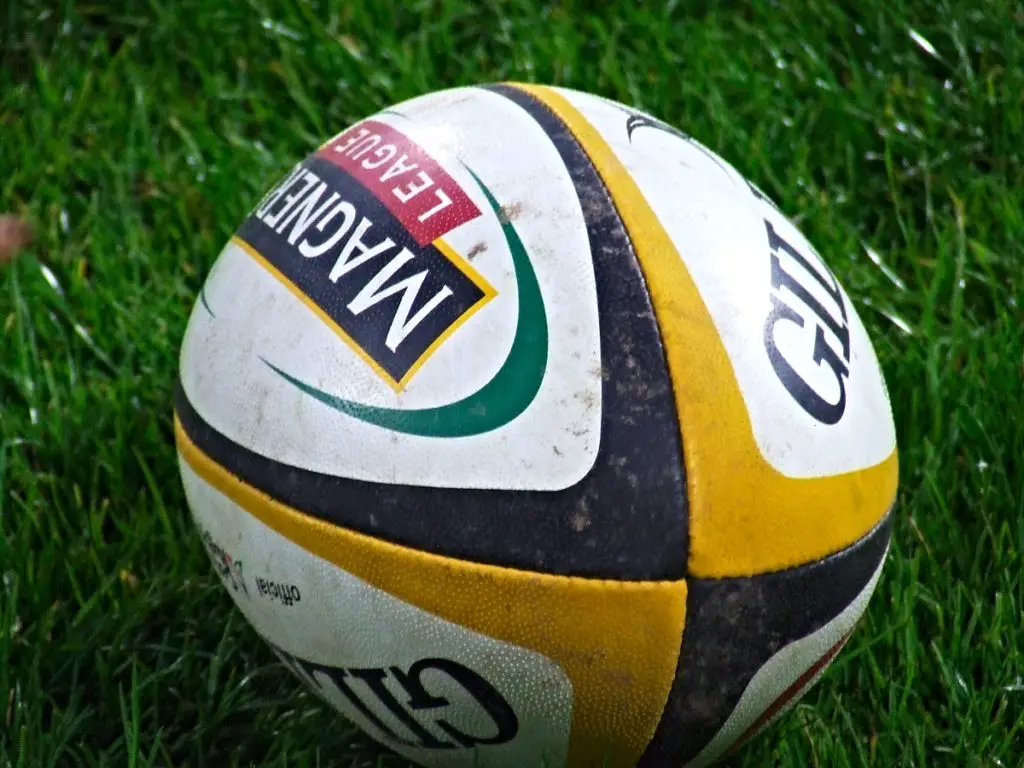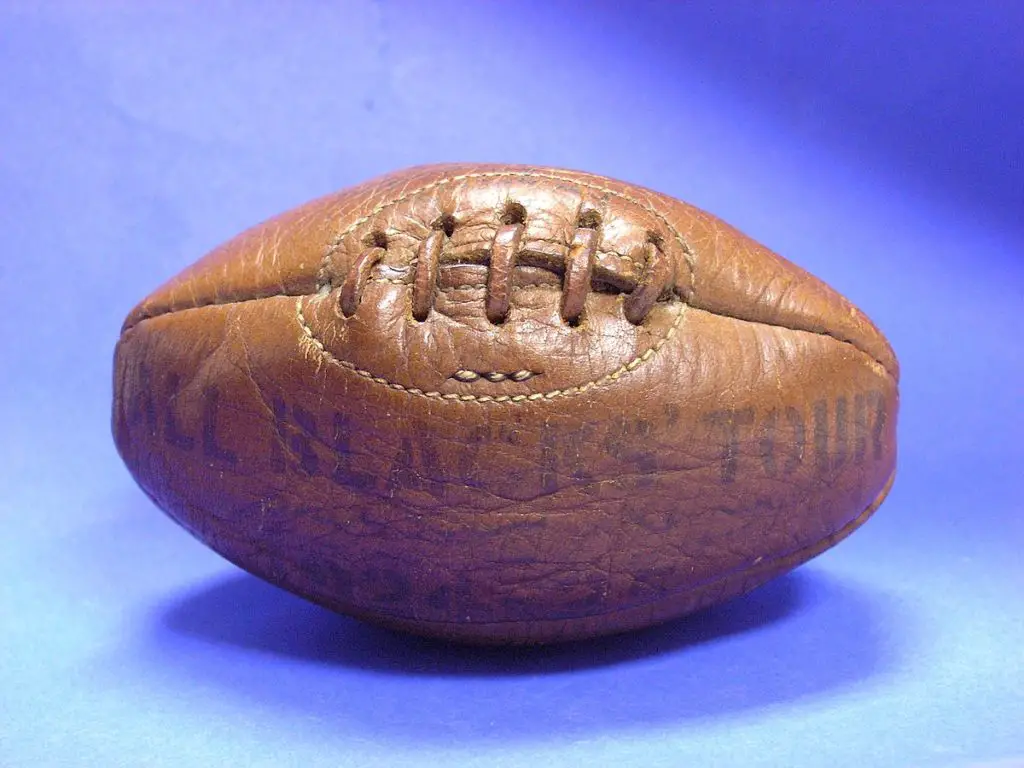Rugby players are often fondly referred to as ‘egg chasers’ due to the odd shape of the rugby ball. But this egg, or rugby ball is not sized and shaped randomly and there is a well established series of ball size and weights for different age groups.
Senior rugby players use a size 5 ball which is 28-30 centimeters long, 410-460 grams in weight and made of a latex inner and four pieces of rubber compound material sewn together to form the outer shell of the rugby ball in the classic oval shape.
In this article, we are going to help you understand the size, shape, and weight of rugby balls so you know exactly what you’re looking for when it comes time to make the selection. Let’s start with our rugby ball size guide.
Rugby ball age group size guide
| Rugby ball size | Weight | Approx Length | Age group |
| 5 | 14-16 oz410-460 gm | 280-290 mm11.02-11.42 in | Adult (15+) |
| 4 | 12-14 oz340-460 gm | 275 mm10.82 in | 10-14 |
| 3 | 10-12 oz283-340 gm | 255 mm10.04 in | 7-9 |
| 2 | 8-10 oz226-283 gm | 240 mm9.45 in | Under 6 |
| Midi | 6-8 oz170-226 gm | 215 mm8.46 in | As appropriate |
| Mini | 3-6 oz85-170 gm | 160 mm6.30 in | As appropriate |
With rugby balls, the phrase one-size-fits-all doesn’t apply. In contrast to other major sports like football, baseball, or soccer which have one standard ball that is universally used, rugby actually has several different ball sizes.
Although rugby balls come in different sizes, they are all the same oval shape. Size 5 is the most common regulation size in the Rugby Union, but sizes 3 and 4 are also recognized sizes for junior and mini players.
Size 2 and the other miscellaneous “mini” sizes are considered to be unofficial sizes and are selected with the hand size of the players in mind.
It is important that younger players do have a suitably sized ball so that they can learn the basic skills correctly.
There is nothing worse than a youngster getting down about their rugby because they can’t kick or pass a ball with decent distance because the size of the ball is limiting their technique and they may not have developed enough power to have much impact on a larger ball yet.
In contrast a nine year old playing with a size 3 ball should be able to experience some success as regards kicking distance and passing length and accuracy. This will hopefully motivate them to continue to pursue the game as they progress through the age groups.
Recommended reading: Age Grade Rules And Progressions (Printable Table)
Here is a little more information about the size and weight of the different types of rugby balls:
Size 5 – Adult – Official Match Ball
The most common rugby ball used in both men’s and women’s professional rugby matches is size 5. They are 15 inches long and weigh about 14-16 oz. when fully inflated. This ball is considered the “regulation” size or “match” ball and is most popularly made by Gilbert.
The air pressure of a size 5 rugby ball needs to be, at the start of play, 65.71-68.75 kilopascals, 0.67-0.70 kilograms per square centimeter, or 9.5-10.0 pounds per square inch.

Size 4 – Junior (10-14 years old)
The size 4 ball is slightly smaller than the full-size ball (or size 5 ball) and measures about 14 inches.
Size 3 – Mini players (7-9 years old)
For young rugby players, the size 3 rugby ball is most appropriate. A size 3 rugby ball is about 13 inches long.
Unofficial Sizes
Size 2 – The next smallest rugby ball is the size 2 ball. This ball is just 12 inches long when fully inflated and is the first of the unofficial sizes.
MIDI – The MIDI size is made for youth rugby and is 10 inches long.
MINI – There is a range of MINI size balls. They come in 6, 7, 8, or 9-inch sizes. MINI balls are designed for young children’s small rapidly changing hands.
Recommended reading: Rugby Boot Rules Made Simple!
Match Balls V Practice Balls
The leading producer of rugby balls, i.e Gilbert, produces a series of practice balls which, whilst costing much less than an official match ball, are still great for skill development but don’t break the rugby club’s bank.
The main difference between and match ball and a practice ball is that practice balls have a higher percentage of synthetic fabric. This means they are actually more durable and robust than a match ball which uses a higher percentage of rubber which makes them easier to grip and handle but not longer lasting.
Practice balls are usually available in all sizes and are fine for everyday practice sessions and handling drills.
Kickers, however, should spend time practicing with the official match balls they are going to play with. Official Gilbert Match balls tend to feel slightly heavier and fly off the foot much faster.
This isn’t such a problem for long range kicks but when trying to judge a delicate chip kick it can be more of a problem with players over hitting the ball.
Finally, match balls tend to feature an improved gripping pattern such as the ’multi-matrix grip’ as offered by Gilbert.
Recommended for you: Rugby Shin Guards: Who Wears Them And Why?
What size rugby ball should be used for each age?
There are different rugby balls geared to specific age groups from young toddlers to adults. It’s important to select the correct rugby ball size for the age of whoever is playing because the balls are designed for the hand size, coordination, and dexterity of each age.
Here is a breakdown of when to use what size rugby ball:
- Under 6s – Size 2
- Under 7s- Under 9s – Size 3
- Under 10s – Under 14s – Size 4
- Under 15 upwards – Size 5
Other ball sizes available include:
- Super Midi (equivalent to size 2.5)
- Midi (equivalent to size 2)
- Mini (equivalent to size 1)
What is a rugby ball made of?
While rugby balls were originally made of a pig’s bladder encased by four panels of leather stitched together to form the now-famous oval shape, it was discovered over time that this design was not as weather-proof as it could be.
Today’s rugby balls are made of four standard panels of synthetic material. The inner bladder of the ball is almost always made of latex and the outer panels are rubber, or a rubber compound that are sewn together to form the oval ball shape itself.
Get the low down on rugby equipment and prices here: Equipment Needed For Rugby: 29 Essential Items Costed

Why is a rugby ball oval?
To the untrained eye, it’s easy to confuse a rugby ball and an American football. Both are a similar ellipse or oval shape. But why was the rugby ball originally made into this shape? Was it just pure chance or was there a reason behind it?
Modern rugby balls are oval because early rugby balls were made from the bladder of a pig. A pig’s bladder is an oval/ellipse shape, so the makers of the first rugby balls formed the four panels of the ball around the oval bladder shape to create the ball.
The rugby balls you see today are made to mimic the shape of those early ones. However, they aren’t made out of pig bladders anymore. Rugby balls are now made in standard sizes just like footballs, soccer balls, and the balls for any other sport.
Although the pig’s bladder has long since been replaced with a latex inner bladder that is inflated, the oval shape has continued to be the standard shape of rugby balls everywhere.
What is the best make of rugby ball?
Rugby balls made by Gilbert are widely regarded as being the best rugby balls available. They supplied the rugby balls at the last world cup in 2019 and are expected to supply balls for the next tournament in 2023 in France.
The only hiccup they experienced in recent time is the world cup ball they they produced for the 2011 tournament called the virtuo match ball. This ball was claimed by some players to not fly through the air in a straight line due to complications involving the valve of the ball.
Jonny Wilkinson was among the most famous players to voice concerns over the ball after he produced one of his worst kicking displays ever. Needless to say that ball has not been seen since that tournament and Gilbert balls continue to impress the world over.
Gilbert has gone on to do significant research into the valves; they use a patented ‘Truflight’ valve which now fits in the seam and seeks to avoid the problems the Virtuoso ball was said to have.
Rugby Union V Rugby League Balls
Rugby Union balls are rounder and shorter than league balls in order to make them more durable in union rucks and mauls, and, the larger size makes them better suited to spiral kicking. League balls are narrower and longer which suits the preferred rugby league style of end over end kicking and passing.
Recommended reading: Rugby and age: What you need to know!
Image Credits
Gilbert rugby Ball SpesBona, CC BY-SA 4.0, via Wikimedia Commons
Classic rugby ball Auckland Museum, CC BY 4.0, via Wikimedia Commons. Miniature rugby ball, presented to Freddie Lucas as a member of the 1924-25 ‘Invincibles’ All Blacks, signed by the entire team brief brown leather and leather lacing; printed- ALL BLACKS 1924-25; signed- FW LUCAS just below lace, with signatures of other team members (faded but legible) markings- printed- “ALL BLACKS’ TOUR 1924-25”; maker’s mark- “MAKER – GILBERT – RUGBY – ENGLAND”

